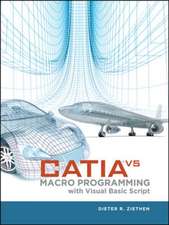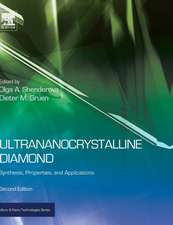Vehicular Communications and Networks: Architectures, Protocols, Operation and Deployment: Woodhead Publishing Series in Electronic and Optical Materials
Editat de Wai Chenen Limba Engleză Hardback – 8 mar 2015
- Comprehensive coverage of the fundamental principles behind Vehicular Ad-hoc Networks (VANETS) and the rapidly growing need for their further development
- Thorough overview of the design and development of key technologies and devices
- Explores the practical application of this technology by outlining a number of case studies, testbeds and simulations employing vehicular communications and networks
Din seria Woodhead Publishing Series in Electronic and Optical Materials
- 24%
 Preț: 1160.66 lei
Preț: 1160.66 lei - 9%
 Preț: 912.54 lei
Preț: 912.54 lei - 39%
 Preț: 1136.44 lei
Preț: 1136.44 lei - 9%
 Preț: 956.68 lei
Preț: 956.68 lei - 24%
 Preț: 951.04 lei
Preț: 951.04 lei - 9%
 Preț: 1335.64 lei
Preț: 1335.64 lei - 29%
 Preț: 986.78 lei
Preț: 986.78 lei - 24%
 Preț: 874.56 lei
Preț: 874.56 lei - 29%
 Preț: 1414.77 lei
Preț: 1414.77 lei - 29%
 Preț: 1075.95 lei
Preț: 1075.95 lei - 9%
 Preț: 1216.61 lei
Preț: 1216.61 lei - 39%
 Preț: 811.62 lei
Preț: 811.62 lei - 29%
 Preț: 1193.77 lei
Preț: 1193.77 lei - 9%
 Preț: 1444.32 lei
Preț: 1444.32 lei - 24%
 Preț: 926.89 lei
Preț: 926.89 lei - 9%
 Preț: 1107.16 lei
Preț: 1107.16 lei - 9%
 Preț: 1262.45 lei
Preț: 1262.45 lei - 9%
 Preț: 954.69 lei
Preț: 954.69 lei - 9%
 Preț: 1006.73 lei
Preț: 1006.73 lei - 9%
 Preț: 958.65 lei
Preț: 958.65 lei - 9%
 Preț: 948.72 lei
Preț: 948.72 lei - 9%
 Preț: 1150.61 lei
Preț: 1150.61 lei - 23%
 Preț: 1493.72 lei
Preț: 1493.72 lei - 24%
 Preț: 1276.29 lei
Preț: 1276.29 lei - 9%
 Preț: 950.94 lei
Preț: 950.94 lei - 29%
 Preț: 1333.73 lei
Preț: 1333.73 lei - 9%
 Preț: 901.22 lei
Preț: 901.22 lei - 9%
 Preț: 1049.49 lei
Preț: 1049.49 lei - 24%
 Preț: 871.12 lei
Preț: 871.12 lei - 27%
 Preț: 1459.23 lei
Preț: 1459.23 lei - 20%
 Preț: 1071.49 lei
Preț: 1071.49 lei - 24%
 Preț: 932.11 lei
Preț: 932.11 lei - 29%
 Preț: 1071.64 lei
Preț: 1071.64 lei - 24%
 Preț: 670.36 lei
Preț: 670.36 lei - 9%
 Preț: 926.48 lei
Preț: 926.48 lei - 23%
 Preț: 929.43 lei
Preț: 929.43 lei - 9%
 Preț: 897.50 lei
Preț: 897.50 lei - 9%
 Preț: 1276.81 lei
Preț: 1276.81 lei - 9%
 Preț: 957.63 lei
Preț: 957.63 lei - 29%
 Preț: 845.10 lei
Preț: 845.10 lei - 9%
 Preț: 953.05 lei
Preț: 953.05 lei - 33%
 Preț: 1126.67 lei
Preț: 1126.67 lei - 29%
 Preț: 954.77 lei
Preț: 954.77 lei - 24%
 Preț: 961.16 lei
Preț: 961.16 lei - 23%
 Preț: 930.29 lei
Preț: 930.29 lei - 23%
 Preț: 1080.19 lei
Preț: 1080.19 lei - 9%
 Preț: 1454.84 lei
Preț: 1454.84 lei
Preț: 1130.18 lei
Preț vechi: 1241.95 lei
-9% Nou
Puncte Express: 1695
Preț estimativ în valută:
216.32€ • 222.92$ • 182.62£
216.32€ • 222.92$ • 182.62£
Carte tipărită la comandă
Livrare economică 24 februarie-10 martie
Preluare comenzi: 021 569.72.76
Specificații
ISBN-13: 9781782422112
ISBN-10: 1782422110
Pagini: 324
Dimensiuni: 152 x 229 x 33 mm
Editura: ELSEVIER SCIENCE
Seria Woodhead Publishing Series in Electronic and Optical Materials
ISBN-10: 1782422110
Pagini: 324
Dimensiuni: 152 x 229 x 33 mm
Editura: ELSEVIER SCIENCE
Seria Woodhead Publishing Series in Electronic and Optical Materials
Cuprins
Related titles
List of contributors
Woodhead Publishing Series in Electronic and Optical Materials
Part One. Architectures for vehicular communication systems
1. Vehicle-to-infrastructure communications
1.1. Introduction
1.2. V2I applications, requirements and related work
1.3. Performance of cellular communication systems for vehicular applications
1.4. System model for the evaluation of the impact of V2I communications on LTE resource utilization
1.5. Channel-aware V2I communications for efficient utilization of cellular resources
1.6. Future trends
1.7. Sources of further information and advice
2. Vehicular ad hoc networks
2.1. Introduction
2.2. Primary applications
2.3. Enabling technologies
2.4. Technical challenges
2.5. Societal challenges
2.6. The future of VANETs
Part Two. Protocols, algorithms, routing and information dissemination for vehicular networks
3. Medium access control in vehicular ad hoc networks
3.1. Introduction
3.2. Requirements and challenges
3.3. IEEE standards for DSRC MAC
3.4. MAC for multichannel
3.5. QoS scheme in MAC
3.6. MAC broadcast mechanism
3.7. Future trends
3.8. Sources of further information and advice
4. Information dissemination in vehicular networks
4.1. Introduction
4.2. Dissemination concepts
4.3. Broadcast-based dissemination
4.4. Multi-hop dissemination and store–carry–forward
4.5. Dissemination via cellular networks
4.6. Future trends
4.7. Further reading
5. Broadcasting in vehicular networks
5.1. Introduction
5.2. Review of related research
5.3. System design
5.4. Factors affecting reliability
5.5. Improving reliability by considering traffic patterns
5.6. Conclusion
6. Opportunistic routing and delay-tolerant networking in vehicular communication systems
6.1. Introduction
6.2. Delay-tolerant networking in vehicular communication systems
6.3. Opportunistic routing in vehicular communication systems
6.4. Conclusions
7. Dynamic spectrum access and cognitive radio for vehicular communication networks
7.1. Introduction
7.2. Dynamic spectrum access and cognitive radio
7.3. Introduction to vehicular dynamic spectrum access
7.4. VDSA with learning
7.5. VDSA implementation
7.6. Summary
8. Modeling and evaluation of location-based forwarding in vehicular networks
8.1. Introduction
8.2. System and modeling assumptions
8.3. Analysis
8.4. Illustrative numerical examples
8.5. Conclusions
9. Security and privacy in vehicular networks
9.1. Introduction and security requirements
9.2. Identity management in C2X
9.3. Privacy protection
9.4. Misbehaviour detection
9.5. Outlook and open issues
Part Three. Operation and deployment of vehicular communications and networks
10. Connected vehicles in an intelligent transport system
10.1. Introduction
10.2. DSRC/WAVE for connected vehicles
10.3. LTE for connected vehicles
10.4. Mobility handling in VANETs based on LTE-A networked femtocells
10.5. Conclusions
11. Test bed for simulations of the effect of a vehicle ad hoc network on traffic flow
11.1. Introduction
11.2. Criticism of generally accepted fundamentals and methodologies of traffic and transportation theory
11.3. Kerner–Klenov stochastic microscopic three-phase traffic flow model
11.4. Model of an ad hoc network
11.5. Simulations of a neighbour table
11.6. Highway control based on ad hoc network
11.7. Prevention of traffic breakdown at an on-ramp bottleneck through vehicle ad hoc network
11.8. Prevention of moving jam emergence in synchronized flow through vehicle ad hoc network
11.9. Effect of danger warning ‘breakdown vehicle ahead’ on congestion patterns
11.10. Conclusions
12. Simulative performance evaluation of vehicular networks
12.1. Introduction
12.2. Mobility
12.3. Wireless communication
12.4. Coupling mobility and network simulators
12.5. Performance evaluation
13. Architectures for intelligent vehicles
13.1. Introduction
13.2. Protocol architectures in communications
13.3. A survey of intelligent vehicle architectures
13.4. An architecture for CDSs
13.5. Conclusion
Index
List of contributors
Woodhead Publishing Series in Electronic and Optical Materials
Part One. Architectures for vehicular communication systems
1. Vehicle-to-infrastructure communications
1.1. Introduction
1.2. V2I applications, requirements and related work
1.3. Performance of cellular communication systems for vehicular applications
1.4. System model for the evaluation of the impact of V2I communications on LTE resource utilization
1.5. Channel-aware V2I communications for efficient utilization of cellular resources
1.6. Future trends
1.7. Sources of further information and advice
2. Vehicular ad hoc networks
2.1. Introduction
2.2. Primary applications
2.3. Enabling technologies
2.4. Technical challenges
2.5. Societal challenges
2.6. The future of VANETs
Part Two. Protocols, algorithms, routing and information dissemination for vehicular networks
3. Medium access control in vehicular ad hoc networks
3.1. Introduction
3.2. Requirements and challenges
3.3. IEEE standards for DSRC MAC
3.4. MAC for multichannel
3.5. QoS scheme in MAC
3.6. MAC broadcast mechanism
3.7. Future trends
3.8. Sources of further information and advice
4. Information dissemination in vehicular networks
4.1. Introduction
4.2. Dissemination concepts
4.3. Broadcast-based dissemination
4.4. Multi-hop dissemination and store–carry–forward
4.5. Dissemination via cellular networks
4.6. Future trends
4.7. Further reading
5. Broadcasting in vehicular networks
5.1. Introduction
5.2. Review of related research
5.3. System design
5.4. Factors affecting reliability
5.5. Improving reliability by considering traffic patterns
5.6. Conclusion
6. Opportunistic routing and delay-tolerant networking in vehicular communication systems
6.1. Introduction
6.2. Delay-tolerant networking in vehicular communication systems
6.3. Opportunistic routing in vehicular communication systems
6.4. Conclusions
7. Dynamic spectrum access and cognitive radio for vehicular communication networks
7.1. Introduction
7.2. Dynamic spectrum access and cognitive radio
7.3. Introduction to vehicular dynamic spectrum access
7.4. VDSA with learning
7.5. VDSA implementation
7.6. Summary
8. Modeling and evaluation of location-based forwarding in vehicular networks
8.1. Introduction
8.2. System and modeling assumptions
8.3. Analysis
8.4. Illustrative numerical examples
8.5. Conclusions
9. Security and privacy in vehicular networks
9.1. Introduction and security requirements
9.2. Identity management in C2X
9.3. Privacy protection
9.4. Misbehaviour detection
9.5. Outlook and open issues
Part Three. Operation and deployment of vehicular communications and networks
10. Connected vehicles in an intelligent transport system
10.1. Introduction
10.2. DSRC/WAVE for connected vehicles
10.3. LTE for connected vehicles
10.4. Mobility handling in VANETs based on LTE-A networked femtocells
10.5. Conclusions
11. Test bed for simulations of the effect of a vehicle ad hoc network on traffic flow
11.1. Introduction
11.2. Criticism of generally accepted fundamentals and methodologies of traffic and transportation theory
11.3. Kerner–Klenov stochastic microscopic three-phase traffic flow model
11.4. Model of an ad hoc network
11.5. Simulations of a neighbour table
11.6. Highway control based on ad hoc network
11.7. Prevention of traffic breakdown at an on-ramp bottleneck through vehicle ad hoc network
11.8. Prevention of moving jam emergence in synchronized flow through vehicle ad hoc network
11.9. Effect of danger warning ‘breakdown vehicle ahead’ on congestion patterns
11.10. Conclusions
12. Simulative performance evaluation of vehicular networks
12.1. Introduction
12.2. Mobility
12.3. Wireless communication
12.4. Coupling mobility and network simulators
12.5. Performance evaluation
13. Architectures for intelligent vehicles
13.1. Introduction
13.2. Protocol architectures in communications
13.3. A survey of intelligent vehicle architectures
13.4. An architecture for CDSs
13.5. Conclusion
Index









